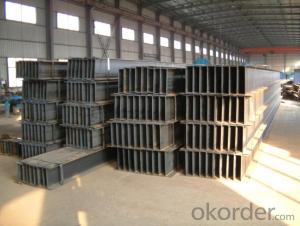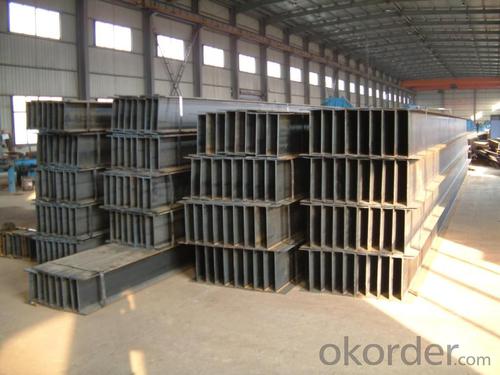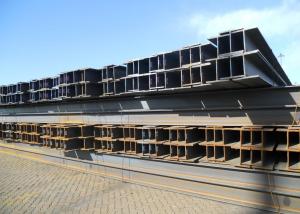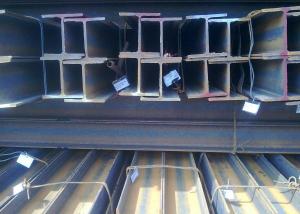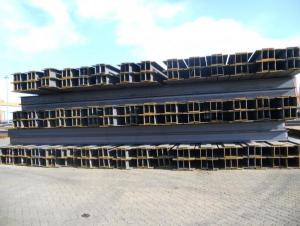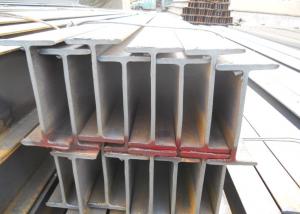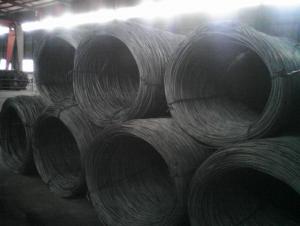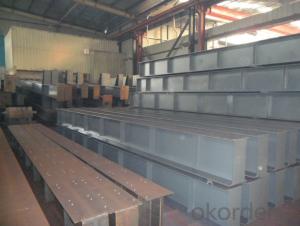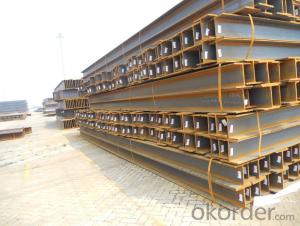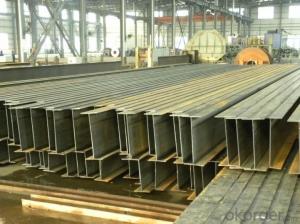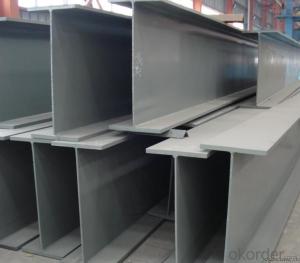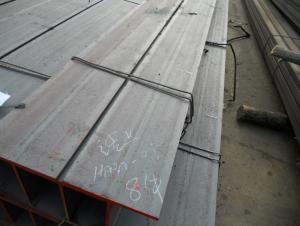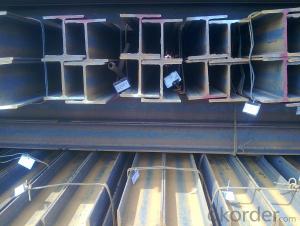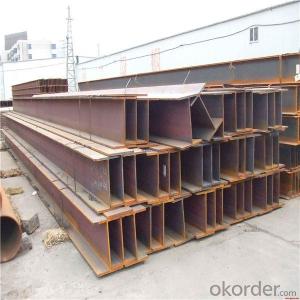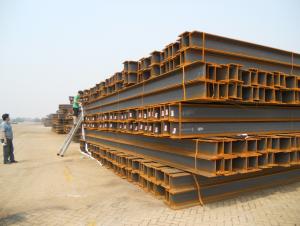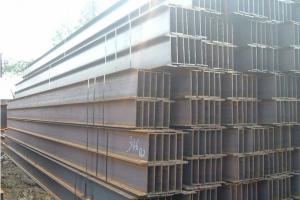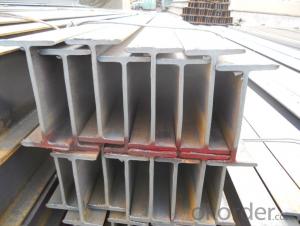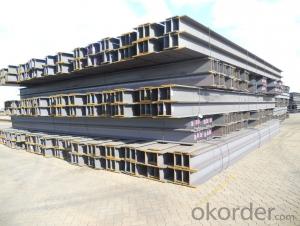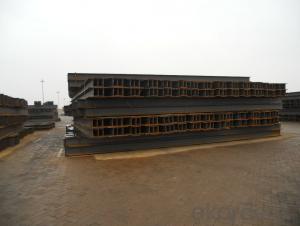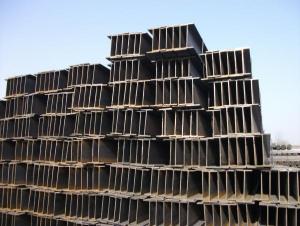GB Standard Steel H Beam 200mm-250mm with High Quality
- Loading Port:
- China main port
- Payment Terms:
- TT or LC
- Min Order Qty:
- 40 m.t
- Supply Capability:
- 15000 m.t/month
OKorder Service Pledge
OKorder Financial Service
You Might Also Like
Specifications of GB Standard Steel H Beam 200mm-250mm with High Quality For Sale:
1. Standard: GB Standard
2. Grade: Q235
3. Length: 12m
Size and Mass:
| Size (mm) | Mass (Kg/m) | Size (mm) | Mass (Kg/m) |
| 200*200*8.0 | 49.9 | 250*125*6.0 | 29.0 |
| 248*124*5.0 | 25.1 | 244*175*7.0 | 43.6 |
Usage & Applications of GB Standard Steel H Beam 200mm-250mm with High Quality For Sale:
Commercial building structure ;Pre-engineered buildings; Machinery support structure; Prefabricated structure; Medium scale bridges; Ship-building structure, etc.
Production flow of GB Standard Steel H Beam 200mm-250mm with High Quality For Sale:
Material prepare (billet) —heat up—rough rolling—precision rolling—cooling—packing—storage and transportation
FAQ:
Q1: Why buy Materials & Equipment from OKorder.com?
A1: All products offered byOKorder.com are carefully selected from China's most reliable manufacturing enterprises. Through its ISO certifications, OKorder.com adheres to the highest standards and a commitment to supply chain safety and customer satisfaction.
Q2: How do we guarantee the quality of our products?
A2: We have established an advanced quality management system which conducts strict quality tests at every step, from raw materials to the final product. At the same time, we provide extensive follow-up service assurances as required.
Q3: How soon can we receive the product after purchase?
A3: Within three days of placing an order, we will arrange production. The shipping date is dependent upon the quatity, how many sizes you want and the plan of production, but is typically 1 month to 2 month days from the beginning of production.
Images of GB Standard Steel H Beam 200mm-250mm with High Quality:
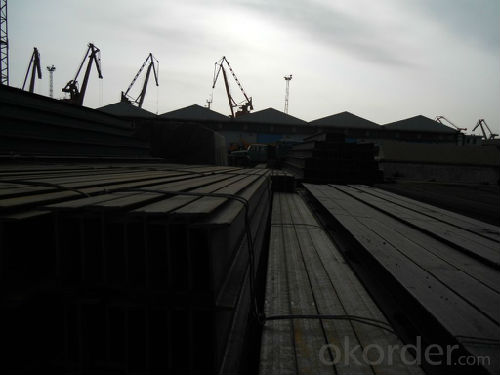
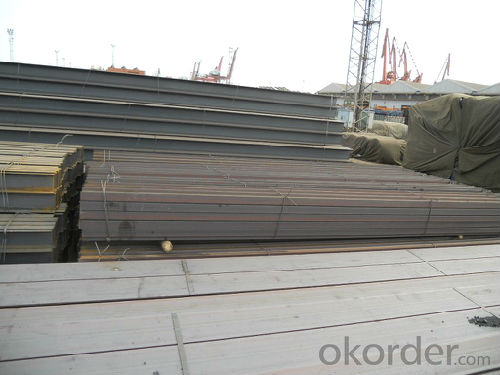
*If you would like to get our price, please inform us the size, standard/material and quantity. Thank you very much for your attention.
- Q: What are the common inspection methods for steel H-beams?
- The common inspection methods for steel H-beams include visual inspection, dimensional checks, and non-destructive testing techniques such as ultrasonic testing and magnetic particle inspection. These methods are used to ensure the quality, accuracy, and structural integrity of the H-beams.
- Q: How do steel H-beams perform in terms of buckling resistance?
- Steel H-beams generally have excellent buckling resistance due to their shape and structural properties. The combination of a compact cross-section and the distribution of material along the flanges and web allows H-beams to withstand high compressive loads without buckling. Additionally, the use of high-strength steel further enhances their buckling resistance, making these beams a reliable choice for various structural applications.
- Q: What are the common defects found in steel H-beams?
- There are several common defects that can be found in steel H-beams. One of the most common defects is surface imperfections, such as scratches, pits, or dents. These can occur during the manufacturing process or due to mishandling during transportation or storage. Another common defect is welding defects. H-beams are often fabricated by welding different sections together, and if the welding process is not performed properly, it can result in defects such as cracks, lack of fusion, or excessive weld spatter. Misalignments are also common defects in steel H-beams. This can occur when the flanges or webs of the beam are not properly aligned, resulting in an uneven or twisted shape. Misalignments can affect the overall structural integrity of the beam and may require corrective measures to ensure proper functionality. In addition, dimensional deviations can be found in H-beams. This can include variations in length, width, or height, which can affect the overall stability and load-bearing capacity of the beam. Lastly, corrosion is another defect that can occur in steel H-beams, especially in outdoor or corrosive environments. If the beam is not properly protected with coatings or if there are gaps in the protective layer, it can lead to rust formation and deterioration of the steel. Overall, it is important to inspect steel H-beams for these common defects to ensure their quality and structural integrity. Regular maintenance, proper handling, and adherence to manufacturing standards can help prevent these defects and ensure the longevity and performance of the beams.
- Q: Are steel H-beams suitable for use in the construction of energy generation facilities?
- Yes, steel H-beams are highly suitable for use in the construction of energy generation facilities. These beams have numerous advantages that make them a popular choice in the industry. Firstly, steel H-beams are known for their strength and durability. They are made from high-quality steel, which provides exceptional structural integrity. This is crucial for energy generation facilities, which often house heavy machinery and equipment. The robust nature of steel H-beams ensures that they can withstand the significant loads and stresses associated with energy generation processes. Additionally, steel H-beams have excellent load-bearing capabilities. They are designed to distribute weight evenly, making them ideal for supporting heavy equipment and structures in energy generation facilities. This feature is crucial, as energy generation facilities often require large machinery, such as turbines and generators, which can be quite heavy. Moreover, steel H-beams are versatile and can be easily customized to meet specific project requirements. They come in various sizes and lengths, allowing architects and engineers to design structures that suit the unique needs of energy generation facilities. This flexibility makes steel H-beams suitable for a wide range of applications in the construction of energy generation facilities. Furthermore, steel H-beams are fire-resistant, which is crucial for ensuring the safety of energy generation facilities. In the event of a fire, steel H-beams will not contribute to the spread of flames, providing valuable time for evacuation and firefighting efforts. Lastly, steel H-beams have a long lifespan and require minimal maintenance. This is particularly advantageous for energy generation facilities, as they operate continuously and require reliable structural support. The durability and low-maintenance nature of steel H-beams contribute to the overall cost-effectiveness of energy generation facility construction. In conclusion, steel H-beams are highly suitable for use in the construction of energy generation facilities. Their strength, load-bearing capabilities, versatility, fire resistance, and low-maintenance qualities make them an excellent choice for supporting heavy machinery and structures in these facilities.
- Q: Can steel H-beams be used in mezzanine floors?
- Yes, steel H-beams can be used in mezzanine floors. They are commonly used as structural supports due to their high strength and load-bearing capacity, making them an ideal choice for creating additional floor space in buildings.
- Q: Are steel H-beams suitable for multi-story parking garages?
- Yes, steel H-beams are commonly used in multi-story parking garages due to their high strength-to-weight ratio, durability, and cost-effectiveness. They provide excellent structural support and can withstand heavy loads, making them suitable for constructing parking garages of multiple levels.
- Q: What are the different types of connections for steel H-beams in industrial buildings?
- There are several different types of connections commonly used for steel H-beams in industrial buildings. These connections are designed to provide stability and strength to the structure, ensuring that the H-beams can effectively support the load they are subjected to. 1. Welded Connection: One of the most common types of connections for steel H-beams is welded connection. In this method, the ends of the H-beams are welded together to form a strong and rigid connection. Welded connections are often used when the loads are mainly axial, ensuring efficient load transfer between the beams. 2. Bolted Connection: Bolted connections involve using bolts and nuts to connect the H-beams. Holes are drilled in the flanges and webs of the beams, and bolts are inserted through these holes and tightened with nuts. Bolted connections offer the advantage of being easily disassembled and modified, making them suitable for situations where flexibility is required. 3. Pinned Connection: Pinned connections are used when the H-beams need to be able to rotate or move freely. In this type of connection, a pin or a bolt is inserted through the flanges of the beams, allowing for movement and rotation. Pinned connections are often used in structures subjected to seismic loads or other dynamic forces. 4. Moment-Resisting Connection: Moment-resisting connections are designed to resist bending moments and provide stability to the structure. These connections are often used in multi-story industrial buildings or structures with high wind or seismic loads. Moment-resisting connections typically involve a combination of welded and bolted connections, ensuring a secure and rigid joint. 5. Shear Connection: Shear connections are utilized to transmit shear forces between the H-beams. This type of connection is typically achieved through welding or bolting plates or angles to the webs of the beams. Shear connections are important in transferring lateral loads and ensuring the structural integrity of the building. Overall, the choice of connection type for steel H-beams in industrial buildings depends on various factors, including the structural design, loading conditions, flexibility requirements, and construction method. Engineers carefully consider these factors to determine the most appropriate connection type that will ensure the safe and efficient performance of the structure.
- Q: How can the steel posts of different types of H steel be butted?
- When bolted and welded composite joints are used, the web shall be bolted and the flanges shall be single plate, V - shaped, bevel, and weld
- Q: Are steel H-beams suitable for use in the construction of sports facilities?
- Yes, steel H-beams are highly suitable for use in the construction of sports facilities. Steel H-beams offer several advantages such as high strength-to-weight ratio, durability, and versatility. They can support heavy loads, provide structural stability, and withstand various weather conditions. Additionally, steel H-beams allow for flexible design options and can be easily fabricated and installed. Overall, their superior structural properties make them an ideal choice for constructing sports facilities that require robust and reliable support systems.
- Q: How do steel H-beams perform in areas with high heat or thermal expansion?
- Steel H-beams are known for their strength and durability, but their performance in areas with high heat or thermal expansion can be affected. Heat causes materials to expand, and steel is no exception. When exposed to high temperatures, H-beams can experience thermal expansion, which can lead to potential issues such as distortion, bending, or even failure. The extent to which H-beams are affected by high heat or thermal expansion depends on several factors, including the temperature, duration of exposure, and the specific type of steel used. Generally, as the temperature increases, so does the expansion of the steel beams. However, different types of steel have varying coefficients of thermal expansion, meaning some may expand more than others under the same conditions. To mitigate the effects of thermal expansion, engineers and architects can take several measures. One common approach is to incorporate expansion joints into the design. These joints allow the steel beams to expand and contract freely without causing damage or distortion to the overall structure. Expansion joints can be strategically placed at intervals along the beams to accommodate the expected expansion and prevent the buildup of excessive stress. Another method is to use steel alloys that are specifically designed to withstand high temperatures and have lower coefficients of thermal expansion. These alloys, such as stainless steel or certain types of heat-resistant steels, are better suited for areas with high heat or thermal expansion. They can better handle the expansion and contraction without compromising the structural integrity. Furthermore, proper insulation and ventilation systems can help regulate the temperature within a building or structure, reducing the risk of extreme heat exposure to the H-beams. Adequate insulation can minimize heat transfer, while effective ventilation can dissipate excess heat and maintain a more stable environment. In conclusion, steel H-beams can be affected by high heat or thermal expansion, potentially leading to distortion or failure. However, through careful design considerations, such as incorporating expansion joints and using appropriate steel alloys, along with proper insulation and ventilation systems, the performance of steel H-beams in areas with high heat or thermal expansion can be improved and their structural integrity can be preserved.
Send your message to us
GB Standard Steel H Beam 200mm-250mm with High Quality
- Loading Port:
- China main port
- Payment Terms:
- TT or LC
- Min Order Qty:
- 40 m.t
- Supply Capability:
- 15000 m.t/month
OKorder Service Pledge
OKorder Financial Service
Similar products
Hot products
Hot Searches
Related keywords
